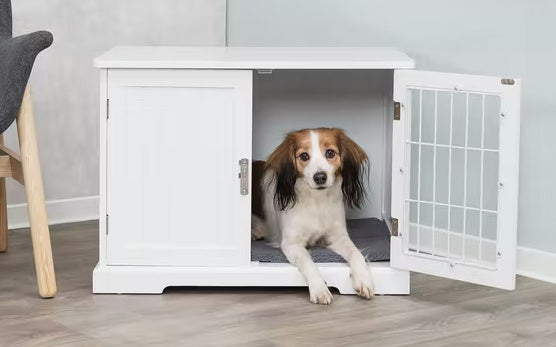A crate, if introduced correctly, can be a wonderful den for your new puppy to rest and sleep in. However, if they are forced into the crate, it becomes a cage and the nice safe zone you are trying to create for your new puppy becomes a punishing space instead. In order to help your puppy learn that their crate is the best spot in the house, you will need to follow the steps outlined below.
Introduce the crate gradually
Place the crate in an area where the puppy can access it easily while still being close to the family. There is no point in having a fabulously comfy crate at the other end of the house where your puppy is never going to use it. Place some non-slip bedding on the floor of the crate e.g. Vetbed to reduce the risk of slipping and prevent your puppy startling if the crate moves and make some unexpected noise. Leave the door open and encourage your puppy to investigate it at its own pace. You can make it extra appealing by tossing something tasty for them to venture in after (& therefore be rewarded for such bravery!)
Make the crate a good place to be
During the day, when you are not training your puppy, leave the crate open and pop your dog’s toys and bed inside so that they start to see the crate as a good space to go to play or have a snooze. Give your puppy their meals, treats and chews in their crate – to begin with you will need to leave the door open but as you work on training your puppy to love their crate you can build up to closing the door.
Slowly build up your puppy to spending time in the crate with the door closed
Once your puppy is happy to trot in and out of their crate, begin closing the door over for a second before opening it again to let them out.

If your puppy appears relaxed about going into their crate and having the door closed for a few seconds you can start to build up the length of time they are closed inside. Once they can remain happily in the crate when they can see you, start to leave the room for a few seconds. You will need to do this slowly to ensure your puppy does not become distressed as this will undo the positive association you have built up to this point.
Reward your dog for remaining calm inside their crate by tossing a treat into them when you return, just before you open the door. This has the added bonus of encouraging your puppy to calmly exit the crate.
If at any point your puppy becomes distressed in the crate and starts to bark, whine or paw at the door, return to the crate but wait for a calm behaviour, such as standing to look at you, before opening the crate. This ensures we are not teaching our puppies that barking makes the crate door open. You can also use this information – maybe you left them a little too long, they need to go to the toilet etc. This way you can ensure that you are pre-empting the barking and avoid a pattern from forming.
If you want to eventually leave your puppy in the crate for longer periods, make sure you provide them with something to occupy them such as a stuffed Kong or a puppy appropriate interactive toy.
Remember a good general rule to follow is no longer then one hour in the crate for each month of age & ideally you should not be crating your dog for more than a few hours a day. And don't forget to leave fresh water available to them at all times.







